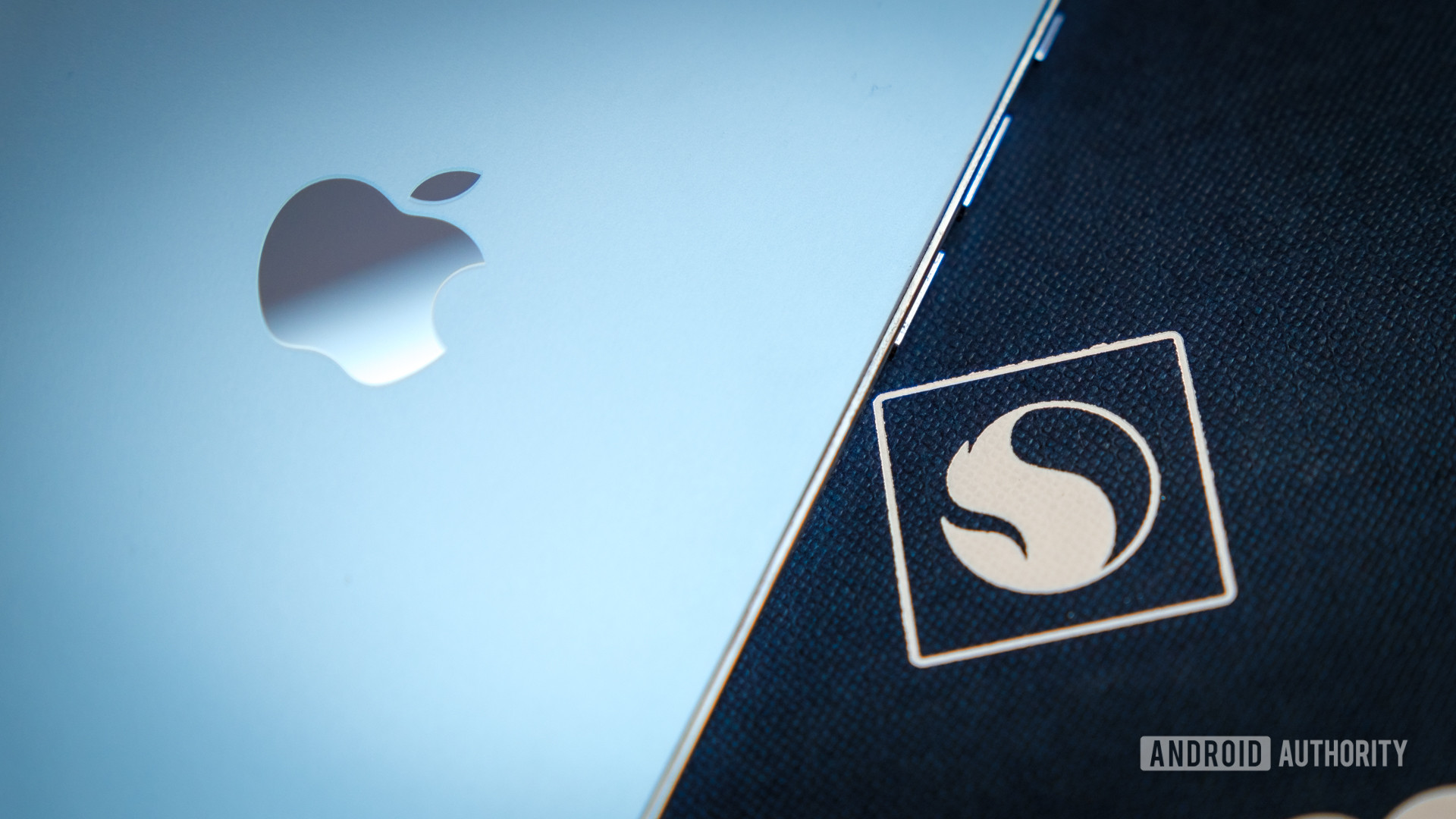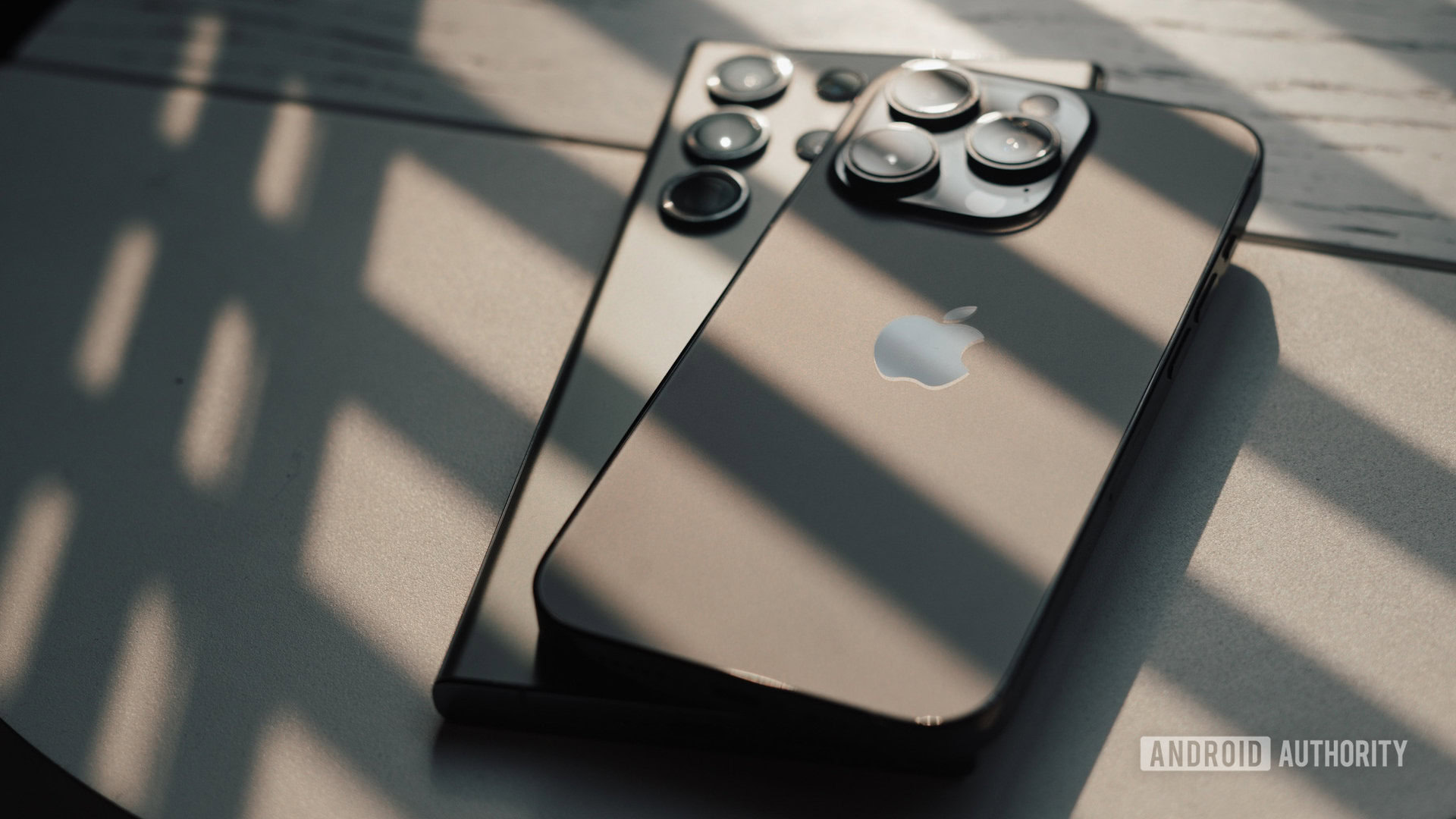Affiliate links on Android Authority may earn us a commission. Learn more.
Apple A17 Pro vs Snapdragon 8 Gen 2: Battle of the next-gen chips
September 27, 2023

The arrival of the Apple iPhone 15 invites plenty of Android comparisons and talking points, none more so than in the chipset department. With a new A17 Pro processor onboard — Apple has ditched the Bionic moniker — we should be looking at a new performance champion, and we’re eager to see how the A17 Bionic compares to the Snapdragon 8 Gen 2 powering today’s best Android phones.
Before diving into the specs, it’s worth noting that Apple no longer packs its more powerful chipset into every new iPhone. The A17 Pro is exclusive to the iPhone 15 Pro and Ultra. The regular and Plus versions use the A16 Bionic that powered 2022’s iPhone 14 Pro and Pro Max. That chip is still plenty powerful, just not quite cutting edge. So let’s dive into the Apple A17 Pro vs Snapdragon 8 Gen 2.
Apple A17 Pro vs Snapdragon 8 Gen 2 specs
As usual, Apple’s latest CPUs are built on its customized take on the Arm architecture. That means CPU cores that you won’t find in the Android space, or anywhere else, which lends the chip a more unique performance profile. As usual, Apple’s A17 Pro features two powerhouse cores boasting an extreme 3.78GHz clock and four energy-efficient cores at a more modest 2.11GHz. Apple hasn’t named them this year.
The Snapdragon 8 Gen 2 uses licensed Arm CPU components: a single Cortex-X3, four Cortex-A715s, and four Cortex-A510s. This setup looks a little more dynamic in the power department and features more cores, but Apple’s bigger cores with higher clocks continue to allow the chip to perform exceptionally in multi-threaded workloads.
| A17 Pro | Snapdragon 8 Gen 2 | |
|---|---|---|
CPU Config | A17 Pro 2x 3.78GHz (High-performance) 4x 2.11GHz (Energy-efficient) | Snapdragon 8 Gen 2 1x 3.19GHz (Cortex-X3) 2x 2.8GHz (Cortex-A715) 2x 2.8GHz (Cortex-A710) 3x 2.0GHz (Cortex-A510) |
GPU | A17 Pro 6-core (Apple-designed) Hardware ray-tracing | Snapdragon 8 Gen 2 Adreno 740 Hardware ray-tracing |
AI | A17 Pro 16-core Apple Neural Engine | Snapdragon 8 Gen 2 Hexagon DSP |
RAM support | A17 Pro LPDDR5 | Snapdragon 8 Gen 2 LPDDR5X |
Video | A17 Pro HEVC, AV1 decode 4K60 capture | Snapdragon 8 Gen 2 HEVC, AV1 decode 4K120, 8K30 capture |
4G/5G Modem | A17 Pro X70 LTE/5G 10,000Mbps down 3,500Mbps up | Snapdragon 8 Gen 2 X70 LTE/5G 10,000Mbps down 3,500Mbps up |
Other networking | A17 Pro Bluetooth 5.3 Wi-Fi 6E | Snapdragon 8 Gen 2 Bluetooth 5.3 Wi-Fi 7 Ready |
Process | A17 Pro TSMC 3nm (N3B) | Snapdragon 8 Gen 2 TSMC 4nm |
Apple was shy on the specifics of the A17 Pro CPUs but touts a rather conservative 10% performance boost over last generation’s Apple A16 Bionic and up to 3x better performance per watt energy efficiency gains for the little cores. That still pushes the A17’s CPU capabilities further beyond the Snapdragon 8 Gen 2, as we’ll see in the benchmarking section. Notably, the A17 even rivals the Snapdragon 8 Gen 2’s successor, the Snapdragon 8 Gen 3, in our separate benchmarks of those two chipsets.
GPU-wise, Apple has some significant changes here. The number of GPU cores moves from five to six, leading Apple to tout a 20% boost to graphics performance. Still, Qualcomm’s Adreno 740 took the lead last year, and it’ll take more than a 20% performance boost for Apple to surpass Snapdragon, it’ll need more sustainable performance too. But the new iPhone has another trick up its sleeve.
After reportedly abandoning the feature last year, the A17 Pro sports hardware ray-tracing capabilities for the first time. Qualcomm’s Snapdragon 8 Gen 2, along with Samsung’s Exynos 2200 and MediaTek Dimensity 9200, also support ray-tracing graphics, so this is a case of Apple catching up. According to Apple, the move to hardware-based ray-tracing shows a 4x performance gain over the A16 Bionic’s software approach. But perhaps most impressive is that the new chip can play a small selection of modern console games too.
Ray-tracing and console titles raise the A17 Pro's gaming prospects.
One of the other big talking points this year and next will surely be Apple’s use of TSMC’s cutting-edge 3nm manufacturing process, an improvement on the evolving 5nm processes used for its past three generations. In fact, Apple is rumored to be the only chip manufacturer using TSMC 3nm this year.
TSMC notes that moving from its 5nm to 3nm process results in a roughly 35% boost to energy efficiency, a boon for battery life, along with a 60% increase in logic density compared to N5. Similarly, MediaTek noted that it can boost performance by 18% for the same power on this node. It looks like Apple has opted for a middle-ground approach, benefiting from both a modest performance boost and battery life gains.
However, the efficiency difference from TSMC’s more advanced 5nm process (such as N4P) to N3 is likely to only be a few percentage points. The Snapdragon 8 Gen 2 might not be too far off the pace in this regard. However, with Apple reportedly the only one willing to pay the fabrication costs, it’s expected that even the next-gen Snapdragon 8 Gen 3 will be built on a next-gen 4nm node rather than 3nm, lending Apple a density and efficiency advantage into 2024.
Apple has closed some other gaps too, with Bluetooth 5.3 connectivity, the same Snapdragon X70 5G modem, and AV1 decoder support as this year’s top Android phones. But the Snapdragon 8 Gen 2 stays in front with Wi-Fi 7 support, 8K video recording capabilities, and options for lossless audio via aptX.
Apple A17 Pro vs Snapdragon 8 Gen 2 benchmarks
With the A17 Pro equipped iPhone 15 Pro in hand, we’ve run our usual benchmark suite against the Snapdragon 8 Gen 2 to see how the two stack up across demanding CPU and GPU workloads. We’ve also run stress tests to see if the iPhone 15 temperature concerns have a knock-on effect for performance.
The CPU results are actually better than Apple’s modest claim of a 10% performance improvement. GeekBench 6’s single-core score jumps by 17%, while our multi-core result is almost 12% higher than last year. The A17 Pro’s two performance cores have seen the biggest boost then, so we’re guessing Apple’s conservative figure was talking about multi-core potential, which is more important for most workloads.
GPU results are more disappointing. That extra graphics core only provides a 1% performance uplift in 3DMark’s Wild Life test. This is because, unlike Android phones, iOS continues to cap the benchmark at 60fps. Still, this is useful to note because the A17 Pro won’t see any performance gains for many less demanding real-world games, although they may be more stable. When we crank up the graphics and run Wild Life Extreme, we see Apple’s claim realized with a 20.7% score improvement, which pushes the handset out in front of the Snapdragon 8 Gen 2 in this test.
However, sustainable performance is the more important half of the equation, and Apple’s gains come at the expense of heat and throttling. The A17 Pro can still only sustain 60fps for a run or two of this test before scores drop by 9%. Thankfully, the scores are quite stable after the initial decline. While the Snapdragon 8 Gen 2 equipped Galaxy S23 Ultra gives up performance quite quickly too, it’s still capable of hitting above 60fps for eight runs before eventually declining to the same performance level as the iPhone 15 Pro. However, we’ve seen Snapdragon gaming phones like the ASUS ROG Phone 7 sustain performance much better, pulling well ahead of the latest iPhone in longer gaming sessions.
The A17 Pro tops the graphics benchmarks, but fails to sustain peak performance.
The A17 Pro’s sustained performance is worse when we look at 3DMark’s Solar Bay ray tracing test. Although the new six-core GPU with ray-tracing hardware leapfrogs the Snapdragon 8 Gen 2 and Dimensity 9200, peak performance lasts all of one run (one minute) before throttling back by a staggering 27%. The harder you push Apple’s GPU, the faster it throttles back. Its Android competitors can sustain ray-tracing workloads for notably longer, though they eventually scale back performance too.
Regarding ray-tracing, Apple claims its new hardware runs the effect 4x faster than last year’s software implementation. However, ray-tracing is just one aspect of scene rendering (there’s models, texture mapping, etc. too), so the Solar Bay benchmark sees an almost 50% score uplift. That’s obviously a substantial improvement that leapfrogs the scores we’ve seen from the Snapdragon 8 Gen 2, but remember, Apple is also throwing another GPU core at the problem, as well as ray tracing hardware.
In terms of who has the more powerful hardware implementation, Solar Bay offers a breakdown of increasing ray tracing workloads, scaling up the rays cast by 2x and 3x in different sections of the test and thereby placing much more demand on the GPU’s ray tracing components.
We’ve already established that Apple’s powerful GPU cores give it an overlead lead (at least in a single run). The A17 Pro’s implementation scales quite similarly to the Snapdragon 8 Gen 2 when doubling and tripling the ray tracing workload, although Qualcomm’s GPU gives up a little less performance in the most demanding stage and drops fewer frames as it’s starting from a lower base. Both have a little bit of headroom in this benchmark before the number of rays becomes a major bottleneck, which is good news for the future of ray tracing mobile games. However, neither GPU scales as well as the Arm Immortalis-G715 inside the MediaTek Dimensity 9200, which gives up very little performance in the 2x workload and holds up the best at 3x too.
Apple A17 Pro vs Snapdragon 8 Gen 2: What to expect

We regularly take 10%-20% yearly performance gains for granted, but it’s far from a given. The A17 Pro continues to prove that mobile chipsets can carve out significant performance gains and the iPhone 15 Pro and Pro Max are two of the best-performing smartphones money can buy. In addition, a jump to a more efficient process node, and several new features (such as AV1 decoding and ray tracing), the A17 Pro is one of the iPhone’s more meaningful chipset upgrades in recent years.
However, the chip has some sustainable performance issues that take the shine off, and given that Apple is a generation ahead on its chipset cadence, there’s room for rivals to catch up in the near future. Not forgetting that Apple is just catching up with some features and performance wins that had pushed Snapdragon (and other mobile chipsets) ahead in some areas in recent years. Android smartphones will see their own boost with the arrival of Qualcomm’s Snapdragon 8 Gen 3 and Google’s Tensor G3, which could push them out ahead again. Regardless, customers won’t be disappointed with flagship processor performance, no matter which side of the Android/iOS divide they’re on.